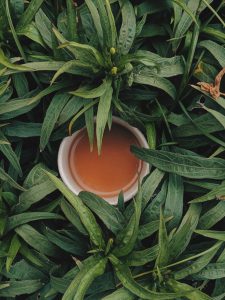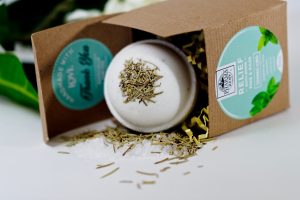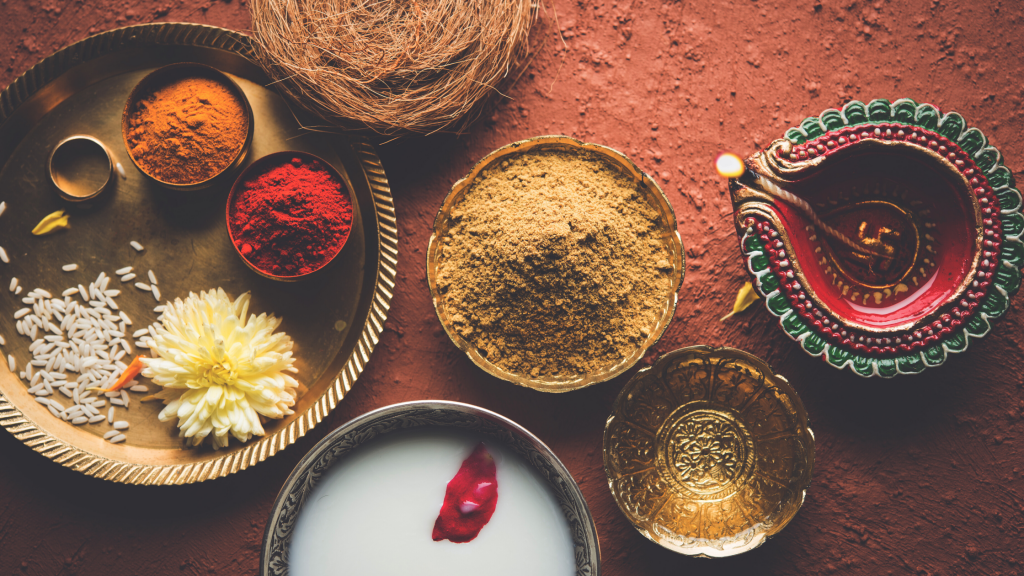If there’s just one thing you’ve got to know about Ayurveda, it’d be how to balance the energies in your body. And one of the best ways to do so is by using ayurvedic herbs.
Knowing what each herb does for your mind and body and then incorporating them into your daily life is one of the key parts of living an ayurvedic lifestyle.
While each herb has its own individual purpose and benefits, they all can kickstart your metabolism, improve digestion, reduce stress and anxiety, and just make your food (or tea) taste better.
Plus, ayurvedic herbs are commonly used during ayurvedic massages and in ayurvedic spas.
In this blog post, I’m going to introduce you to 15 of the best Ayurvedic herbs and their superpowers.
Plus, dive deep into how to use these herbs, their benefits, and potential side effects.
Let’s get brewing!
Disclaimer: This blog post contains affiliate links. I may earn a small commission to fund my essential oil shopping spree habits if you use these links to make a purchase. You will not be charged extra, and you’ll keep me supplied in good-smelling oils. It’s a win for everyone, really.
But First…What Exactly Is Ayurveda?
Before jumping into ayurvedic herbs and their usages, let me give you a quick rundown of what Ayurveda is.
Ayurveda is a holistic and natural system of medicine that originated in India. It gets its name from the Sanskrit words ayur—meaning life—and veda—meaning knowledge.
When translated, Ayurveda literally means “the knowledge of life.”
The primary principle of this healing system is that becoming and remaining healthy starts with the mind. The mind and body are connected, and nothing has more power to heal the body than the mind.
Your mind has the ability to create balance, which extends to the rest of the body, healing it.
To reach that total balance, you can implement lifestyle changes and herbal remedies that Ayurveda promotes. Examples include eating foods that balance your dosha, practicing meditation and yoga, and using ayurvedic herbs in your diet.
Having originated over 5,000 years ago, Ayurveda was the primary system used by people and doctors to treat physical and mental health. The practices, procedures, and principles were recorded in the Vedas.
Though many people in the world are still unfamiliar with it today, Ayurveda is considered by many medical professionals to be the oldest medical system in the world.
And to this day, it’s still one of India’s most commonly used methods of traditional healthcare.
Think you got it?
Let’s find out how to determine which ayurvedic herbs you should be focusing on!
How to Determine Wich Ayurvedic Herbs Are Best for You
To gain a better understanding of how you should use herbs, you must first understand your dosha.
In Ayurveda, it’s believed that each individual is born into the world with their own unique force composed of the five basic elements of nature—earth, air, water, fire, and space.
While we all have the five elements within us, each person has a different amount of a few particular elements.
The balance of these elements is called a dosha. There are three doshas in Ayurveda—Vata, Pitta, and Kapha. An ideal balance among all three would be a sign of outstanding health.
Vata is made of space and air, and is the most powerful of all three doshas in the body. It oversees all the basic human functions, such as breathing, blinking, and even the beating of the heart.
Pitta represents fire and water. It’s responsible for maintaining body temperature through the natural processes that occur in the body, mainly the conversion of food.
Finally, Kapha stands for water and earth. It maintains resistance and immunity and thus manages the production and development of the body’s cells.
In Ayurveda, all health problems stem from an imbalance of one (or several) of the three doshas. So it’s important that you first determine which one dosha you primarily are. Your primary dosha is the one that needs to be brought back into balance.
So after discovering it, find out which Ayurvedic herbs are best for balancing your specific dosha!
You can find out what your dosha is by taking quizzes online, such as The Chopra Center’s Dosha Quiz, Joyful Belly’s Dosha Quiz, and Maharishi Ayurveda’s Dosha Quiz.
How to Use Ayurvedic Herbs: 4 Ways to Effortlessly Implement Them in Daily Life
The best Ayurvedic herbs can be found in a variety of forms and can be used in many different ways.
Please note that anyone who intends to use ayurvedic herbs should do so under the guidance of an experienced ayurvedic practitioner, a certified herbalist, or a professional in naturopathy.
Though Ayurveda is a traditional and globalized system of medicine, it’s still possible to experience complications or side effects when embarking on this life-changing journey.
Self-treating any medical condition would be unwise, and if you experience any major side effects, make sure to put a stop to the treatments you’re taking right away.
Should your symptoms worsen, visit your doctor and inform them of any herbs or practices that you’ve recently taken up. To ensure a smooth transition into an ayurvedic lifestyle, make sure to always keep your trusted medical professional aware of your intentions and actions, and to always take into consideration any advice they give.
1. Drink ayurvedic herbs as teas.
Tea made from herbs is a classic in ayurvedic medicine. Ayurvedic tea is divided into three types, one for each

dosha: Vata tea, Pita tea, and Kapha tea.
Anyone with a dosha imbalance will find relief in a cup of tea made with the right balancing herbs.
Even if you don’t have a dosha imbalance, ayurvedic tea is a great way to maintain balance, improve and further strengthen your health, and simply enjoy a nice, detoxifying drink.
You can take your pick from a lot of ready-made teas that already have ayurvedic herbs infused in them, but you can also easily make your own.
It’s just a matter of finding the right herbs and blends. There are also ayurvedic herbs available in powder form, so you’d only have to add water to make tea.
2. You can cook with ayurvedic herbs.

Even if you’re just starting out with the ayurvedic way of life, you may find that you already have lots of essential herbs sitting right in your cupboard.
Some ayurvedic herbs commonly used in cooking are cumin, turmeric, and saffron.
Digestion is one of the main factors addressed in ayurvedic medicine, and herbs are phenomenal when it comes to aiding the digestive process.
Plus, they boost immunity and—much like tea—can balance out your doshas. Herbs not only give your favorite recipes that magical burst of flavor, but you’ll also find that they’re a great aid to your health.
3. You can take the herbs as pills.
If you’re looking to consume ayurvedic herbs as a daily supplement, you can easily find them in the form of herbal tablets.
These tablets are usually more potent and so, the effects may manifest more quickly and noticeably. This method gives you the opportunity for a more direct connection and a deeper relationship between the herbs and your body.
Each person will respond differently to herbal tablets, so it’s important to practice caution and to be completely informed of the nature of herbs you’ll be taking.
It’ll also be helpful to monitor your progress as your body starts to reap its effects after regular use.
And remember to always consult your doctor or physician before taking any supplements, especially if you’re pregnant, are planning to be, or have preexisting medical conditions.
4. You can use them in skin and hair products.
Each dosha has physical characteristics that determine skin condition. When a dosha is out of balance, one of the most notable signs will be the condition of your skin (such as dryness or excessive oil).
Any topical salve, cream, or oil made from ayurvedic herbs you use should act in opposition to the characteristics of the dosha in question.
There are several best ayurvedic products for all your skin and hair concerns. Their main objective is to address the problems with your dosha and to promote healing through a safe and natural process.
You can even create your own herbal treatments as long as you have the correct herbs and the proper formulas.
As I mentioned earlier, the three doshas manifest in different forms on the hair and skin.
Too much Pitta causes redness and swelling in the skin, and premature thinning and greying of the hair.
An improper amount of Vata gives you dry, scaly, acne-prone skin, as well as frizzy and lusterless hair.
Finally, an imbalance in Kapha appears as rashes and oiliness, both in the skin and the hair.

15 Must-have Ayurvedic Herbs and Their Superpowers
Now that you know what Ayurveda is at its core, how to find herbs right for you, and the different ways you can use ayurvedic herbs, let’s get into 15 of the most powerful ones!
Ayurvedic herbs have been used for centuries because of their extraordinary effects on a person’s physical, mental, and emotional health.
But like any form of medication, ayurvedic herbs may produce side effects and/or interact with other acting medicines. So we’ll also take a look at each herb’s potential side effects, so you know what to watch out for.
Keep in mind that it’s also highly recommended that children, pregnant women, and nursing moms refrain from taking any ayurvedic herbs in high doses or as a standalone medicine.
With that said, let’s explore the 15 ayurvedic herbs you should be adding to your shopping cart!
1. Ashwagandha
Ashwagandha is an ancient medicinal herb. It’s technically classified as an adaptogen, meaning that it helps your body manage its stress levels.
Aside from that, it’s also fantastic for lowering blood sugar levels, alleviating symptoms of depression, and strengthening the body’s primary functions.
Its ability to help the body adapt to stress is reflected in its unique constitution as a plant that thrives in poor and parched conditions. Most plants that live in unfavorable environments—such as dry climates and inferior soil—would suffer, but the Ashwagandha flourishes.
Potential Side Effects of Ashwagandha
When taken for a short amount of time, you won’t usually experience any serious side effects from Ashwagandha. However, some people have reported coming down with headaches, drowsiness, and abdominal discomfort, even in average dosages.
Individuals who have an existing case of hyperthyroidism should refrain from taking this herb, as it may increase thyroid function.
2. Turmeric
Turmeric is one of the most commonly used ayurvedic spices of all time. Not only is it a fundamental cooking ingredient (especially when it comes to curry recipes), but it can also be taken as a dietary supplement.
It’s a major component of many different skin and hair products as well. You’d be hard-pressed to find a health concern that turmeric can’t assist.
To name a few, turmeric stimulates digestion, keeps your joints mobile, promotes healthy blood sugar levels and proper liver functions, boosts immunity, and supports the brain, heart, nervous system, and circulatory system.
Potential Side Effects of Turmeric
Regular use of turmeric usually won’t garner any severe side effects, but it’s been known to cause an upset stomach in a few people. Bouts of nausea and diarrhea have been reported as well. This is most likely to happen when ingested in higher amounts, as the same agents that stimulate digestion may cause irritation to the system.
3. Triphala
Triphala is a powerful formula that contains three different ayurvedic herbs—amla, myrobalan, and belleric myrobalan.
It’s one of the Rasayana herbs, which are said to be “paths of essence.”
A few of Triphala’s famous uses are treating problems related to blood pressure, cholesterol, weight control, and diabetes. It’s also believed to delay or even prevent illnesses that are associated with age, like heart conditions and cancer.
Potential Side Effects of Triphala
Because Triphala has mild laxative properties, the most common side effects of taking it would be related to the gastrointestinal system. This includes abdominal cramps, gas, and diarrhea.
4. Hibiscus
Hibiscus is famous for its beautiful flowers that lack any trace of fragrance. This plant has been used for ages for its diuretic properties and blood-thinning abilities.
It also stimulates blood circulation in the scalp and increases the supply of essential nutrients to the hair roots, encouraging the growth of thick, healthy hair.
Because hibiscus has cooling attributes, its abilities also include regulating body temperature, detoxifying the liver, reducing inflammation, lowering blood pressure, and bringing down appetite levels.
It’ll also do wonders for lifting your mood!
Potential Side Effects of Hibiscus
Because of its significant effect on blood pressure, hibiscus might interact with certain antihypertensive drugs. It may also cause a few side effects such as dizziness and fatigue when consumed in a higher amount than recommended.
Excess doses could also potentially cause damage to the liver, and may also interfere with estrogen levels, which could impact fertility and pregnancy.
5. Shatavari
Shatavari is popular for its ability to soothe and balance out the Vata and Pitta doshas, thanks to its cooling and refreshing properties.
Aside from its rejuvenating effects, this herb is also great to take as an aid in digestive and reproductive health. It also improves memory, gives the immune system a boost, and has positive effects on anxiety, constipation, diabetes, heartburn, and bronchitis.
Potential Side Effects of Shatavari
Shatavari is a member of the asparagus family, so those who have an asparagus allergy should stay clear of it. It also has a slight diuretic effect, which might interact with the metabolizing effects of other medications.
Additionally, anyone with hormone-sensitive conditions should refrain from taking Shatavari, as it might contain a class of compounds that has estrogen-like effects called phytoestrogens.
6. Boswellia
Boswellia comes from the resin of the Boswellia tree, and it’s also commonly known as “Indian frankincense.”
As its name attests, it’s rich in boswellic acid, which is famous for its amazing anti-inflammatory properties. It’s believed that this ayurvedic herb largely aids in the treatment of chronic inflammatory conditions, particularly respiratory and cardiovascular diseases.
Potential Side Effects of Boswellia
Common side effects known to occur during the usage of Boswellia are nausea, stomach pain, and diarrhea. When applied topically, some individuals may develop a rash.
7. Brahmi
Brahmi is known botanically as Bacopa monnieri, and is a popular detoxifying ayurvedic herb that improves brain functions like concentration, memory levels, and general intelligence.
It also has anti-inflammatory and pain-killing effects on the body. This herb also acts as a laxative, which can be helpful in stimulating the proper digestion of food.
Potential Side Effects of Brahmi
Higher dosages may bring about a number of side effects, such as nausea, bloating, abdominal cramps, and fatigue.
8. Bitter Melon
As the name would give away, the Bitter Melon—also sometimes known as Bitter Gourd—plant is very bitter in taste.
Despite this, it’s a very popular vegetable and is even a staple in most Indian households.
A few of its amazing benefits are clearing up skin disorders and healing wounds. Because of its laxative effect, Bitter Melon is also useful for constipation and common digestive problems.
It’s highly effective in other concerns of the body as well, such as purifying the blood, relieving inflammation, and any problems related to the urinary tract.
Potential Side Effects of Bitter Melon
Too much Bitter Melon in your diet might bring stomach pain and diarrhea. If you ingest the seeds at an excessive amount, headaches and fever can follow, too.
9. Holy Basil/Tulsi
Holy Basil—or, Tulsi—is called the sacred “Goddess of Devotion” in Indian culture.
It’s an ancient herb that many countries treasure and two of its most common uses are for religious and medicinal purposes.
While it’s typically used as an essential oil in Ayurveda, its leaves are completely safe for cooking and are even said to preserve and enhance the flavor of food.
Besides that, it also contains anti-inflammatory and antioxidant properties, wards off infections, and speeds up the healing of wounds. Plus, it makes for an excellent ingredient in skin products, as it removes the dirt blocking the pores and prevents premature skin aging.
This seemingly magical herb also curbs depression, stress, and anxiety, as it possesses components that stimulate the hormones that give off feelings of happiness.
Potential Side Effects of Holy Basil
Those who suffer from low blood sugar should be cautious about taking holy basil, as it may aggravate the condition. It’s also known to decrease fertility, so anyone who’s trying to get pregnant should avoid it at all costs.
10. Trikatu
Trikatu is made up of three herbs: pippali, ginger, and black pepper. Its name literally means “three pungents.”
These herbs work together to stimulate digestion, promote proper bile function, spark healthy detoxification, and instigate metabolism.
Because it causes a mild heating action, this classic herb is useful for supporting the overall gastric function. It also promotes a smoother respiratory process and strengthens the muscles, bones, and joints.
Those suffering from problems with their Kapha dosha would benefit the most from Trikatu.
Potential Side Effects of Trikatu
Heartburn, acidity, and a burning aftertaste are the most common side effects of taking Trikatu. Too much consumption of this herbal blend might also end in sweating, redness of the eyes, and mouth ulcers.
11. Gotu Kola
There’s a reason why Gotu Kola is known as “a pharmacy in one herb”—its benefits are truly endless!
It’s also referred to by many as the “elixir of life.”
Gotu Kola builds the body’s resistance to stress, anxiety, and fatigue, making it one of the most well-known herbs with powerful properties.
And like most ayurvedic herbs, it’s also a terrific digestion aid and blood purifier.
It also possesses anti-bacterial, anti-inflammatory, and antioxidant agents.
Potential Side Effects of Gotu Kola
High doses may bring a variety of side effects, particularly nausea, itching, burning sensations, and sensitivity to light.
12. Cardamom
Cardamom is an Indian spice with a distinctly strong taste. Because of this, it’s extremely useful for balancing the Kapha dosha.
Having a Kapha imbalance can cause issues related to mucus, phlegm, weight gain, and lethargy. So if you’re having these symptoms, Cardamom could be the cure.
It offers a number of health benefits, such as boosting the body’s digestive properties, eliminating nausea, relaxing the joints and muscles, improving asthma, and cleansing the lymphatic system.
Potential Side Effects of Cardamom
Cardamom is a popular cooking ingredient and is safe to consume for most people.
There’s no set limit for taking cardamom as an herbal supplement, as there are usually no reports of extreme side effects.
However, it’s worth noting that individuals with gallstones shouldn’t take any amount of cardamom that would exceed the normal amount found in food, as it can trigger gallstone colic. Everyone should also be wary of certain drug interactions, as well as allergies.
13. Manjistha
Manjistha—scientifically known as Rubia Cordifolia—is a flowering plant that purifies the blood, revives circulation, and aids the lymphatic system.
This herb also comes with a compound known as Alizarin, which contains antibacterial properties.
It’s great for improving digestion, relieving arthritis, and flushing out toxins. And when applied to the skin, Manjistha counters dryness, itchiness, and inflammation.
For those suffering from problems with their doshas, Manjistha is especially helpful for balancing out improper Pitta and Kapha levels.
Potential Side Effects of Manjistha
Regular intake may cause constipation, and though rare, it might change the color of one’s urine and stools.
14. Amalaki
Amalaki, also sometimes known as amla or Indian gooseberry, is a small, round fruit.
Because of its myriad of restorative abilities, it’s widely known as the “mother of herbs.”
It provides support for the entire body, mind, and immune system, and encourages the proper functioning of the digestive system, metabolism, and the liver. Amalaki has a high amount of Vitamin C, so it contains strong antioxidant powers.
Potential Side Effects of Amalaki
If consumed in excess amounts, Amalaki may cause stomach acidity, constipation, and problems in certain conditions such as pregnancy or diabetes.
15. Guggul
Guggul is one of the best ayurvedic herbs when it comes to cutting down cholesterol.
It comes from the sap of the Guggul tree and is native in South Asia, Central Asia, and North Africa. Many people also use Guggul as incense, thanks to its fragrant resin.
For centuries, people used Guggul to treat heart ailments. Today (and as early as the seventh century), it treats a multitude of health concerns, such as arthritis, hemorrhoids, gingivitis, liver disease, and even acne.
Potential Side Effects of Guggul
When used in moderation, Guggul is completely safe to consume. Any side effects you can expect would be headaches and nausea. More severe side effects would be diarrhea or vomiting.
It could also stimulate the thyroid, so anyone with a thyroid problem should avoid using Guggul, or at least consult a doctor beforehand. It may also interfere with certain blood disorders, so anyone taking medication for such concerns should refrain from using this herb as a dietary supplement.
And there you have it!
15 of the best ayurvedic herbs and their superpowers. By now, you should feel confident in your ability to determine which herbs are best for your dosha, have a basic understanding of Ayurveda, and know the most common ways to use your new ayurvedic herbs.
So what are you waiting for?
That fresh herb list won’t brew itself!
Elise is an independent creative with a background in Visual Arts, Design, and Fashion. In the past few years, she has worked as a writer, designer, and artist for various clients, brands, and start-ups. In her spare time, she loves to garden, work out outdoors, and spend time with her family and their many, many pets.

